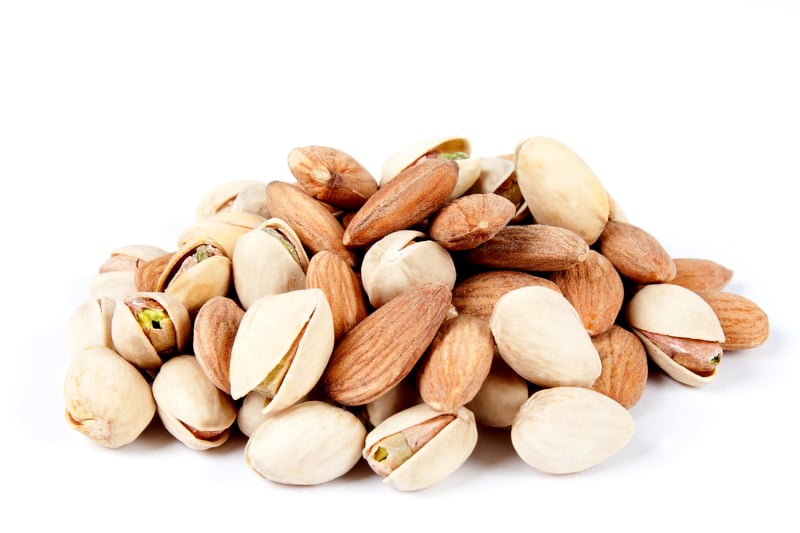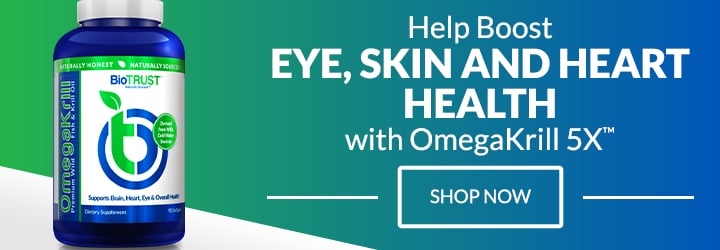Healthiest Nuts: The 3 Best Nuts for Snacking (see chart)

If you’re seeking a simple, nutritious, convenient, portable snack, you can’t go wrong with nuts. They are a good source of plant-based protein and healthy, filling fats, and they’re also jam-packed with phytonutrients. Numerous studies have highlighted their strong health benefits, including helping the body better deal with inflammation and decreasing the risks for numerous diseases.
There are so many choices, and taste is certainly a big consideration. Yet if you’re seeking the healthiest nuts, which should you reach for first?
Here’s our list of the top three healthiest nuts; reach for one of these—or a combination of all three—the next time you have a snack attack!
3 Healthiest Nuts for Snacking#1 Healthiest Nut: Walnuts

While it’s true walnuts are relatively higher in calories and fat than other nuts, there’s a good reason they’re at the top of the list. With 2 ½ grams per ounce, they’re a robust source of the essential omega-3 fatty acid alpha-linoleic acid (ALA). And they’re one of the few plant foods that can claim that distinction. 1 A single serving of walnuts per day provides even more than the recommended amount of ALA of 1.6 grams per day.
Walnuts are also high in fiber, vitamins, and minerals. Even more, walnuts are a healthy source of antioxidants; in fact, walnuts are second only to pecans when it comes to polyphenols and antioxidant capacity. 2 They’re especially high in vitamin E, melatonin, and polyphenols, which is found in high amounts particularly in the papery “skin” of the walnut.
The polyphenols, ALA, magnesium, and the amino acid arginine found in walnuts have also been shown to support the body’s ability to fight oxidative stress and inflammation. 3 And walnuts have been associated with improved blood lipids (such as cholesterol and triglycerides) and blood pressure, as well as a reduced risk of heart disease.
One study published in the journal Metabolism found that after consuming 43 grams (about ½ cup) of walnuts daily for 8 weeks, subjects’ levels of non-HDL-cholesterol and apolipoprotein-B (a protein needed for fat metabolism that’s also found in very-low-density and low-density lipoproteins [VLDL and LDL]) significantly decreased. 4 This is important because these blood lipids are now considered to be more important markers of risk for heart disease than the more commonly used LDL cholesterol.
A similar study in the journal Nutrients found that walnuts may also be useful for those looking to reduce the risk for type II diabetes. 5 And another study from the same journal found that a walnut-enriched diet could improve the health of the gut microbiome. 6
Walnuts have also been shown to potentially help support healthy blood pressure, 7 healthy aging, 8 and brain function. 9, 10
And while the calorie density of walnuts may cause some concern, research suggests that walnuts provide 21% fewer calories than expected—just 146 calories for a ¼-cup serving vs the calculated value of 185 calories per serving. 11
What’s even better is that walnuts may help control hunger. For instance, in one small study, people who consumed 48 grams of walnuts as part of a morning smoothie reported decreased appetite, and practically speaking, they were better able to resist tempting foods throughout the day. 12
Because of their energy density, remember to keep your potions under control. A 28-gram serving is just a ¼ cup, or 12 to 14 walnut halves. Stick to just a small handful rather than opening up a bag and chowing down. Walnuts also make a great addition to salads, and you can also combine them with some roasted chicken, diced apples, and mashed avocado to make a super-delicious and nutritious chicken salad.
#2 Healthiest Nut: Almonds

One of the most popular nuts, almonds are a rich source of healthy fats, fiber, vitamins, and minerals. Often overlooked when it comes to nuts in general, almonds are also loaded with powerful antioxidant phytochemicals, including polyphenols, such as flavonoids, as well as phytosterols. These don’t get the same degree of love as fats, proteins, and carbs, but they likely play a significant role in many of the health benefits we assign to plant-based foods like almonds.
Like most nuts, almonds are considered calorie-dense; however, they’re also exceptionally high in nutrients. A single 28-gram (¼ cup) serving provides 161 calories, 2 ½ grams of net carbs, 3 ½ grams of fiber, 6 grams of protein, 14 grams of fat, and 37% of the Recommended Daily Intake (RDI) for vitamin E, 32% of the RDI for manganese, and 20% of the RDI for magnesium. They’re also a good source of copper, vitamin B2, and phosphorus.
Just as with walnuts, the body doesn’t absorb all of the estimated calories in almonds—some 10 to 15% aren’t absorbed. And you’ll find plenty of protective antioxidants in just a small handful—especially in the skin. So, forget the blanched or peeled almonds and look for raw or roasted nuts instead. 13 Antioxidants, as a reminder, help protect against oxidative stress and the damage it can do, leading to inflammation, aging, and diseases. 14
In fact, you can find few better sources of the antioxidant vitamin E than almonds, and dietary vitamin E has, in turn, been associated with lower risk for heart disease, 15 cognitive decline, 16 and some cancers. 17 Keep in mind these benefits seem to be tied to consumption of foods rich in vitamin E, not run-of-the-mill, synthetic vitamin E supplements, which may actually do more harm than good.
Other potential benefits (and additional reasons why almonds are on the healthiest nuts list) include helping control blood sugar levels, an effect perhaps due to almonds’ magnesium content, which many of us are deficient in. 18 Almonds may also support healthy blood pressure, lower LDL cholesterol and reduce belly and leg fat, 19 improve insulin sensitivity, and reduce the risk of heart disease. 20
With their low-carb, high-protein, and high-fiber content, it’s not surprising that almonds also help control appetite and increase feelings of fullness, which typically results in consuming fewer calories. 21 Several studies have even shown that almonds can help people lose weight. 22, 23
Again, it’s a good idea to keep the serving size small—a ¼ cup, or around 23 almonds—but almonds may be one of the best, healthiest nuts you can enjoy.
#3 Healthiest Nut: Pistachios

Pistachios have so much going for them: They’re delicious, somewhat sweet, and convenient, of course. In other words, they make for an almost-perfect snack. They also have the added benefit of built-in portion control—as long as you get those that are still in the shell. After all, the shell helps you slow down and eat more mindfully. One study, for example, found that folks who had to take the pistachios out of their shells consumed 41% fewer calories than folks given pistachios that had already been shelled. 24
Like both walnuts and almonds, pistachios are one of the healthiest nuts due to their nutrient density and have been found to support gut health, weight loss, and heart health.
A 1-ounce, or ¼-cup, serving (almost 50 pistachios) provides 159 calories, 5 grams of net carbs, 3 grams of fiber, 6 grams of protein, and 13 grams of fat. They’re one of the lowest-calorie, higher-protein nuts. Plus, they have the highest ratio of essential amino acids of all the nuts 25 along with being a good source of the semi-essential amino acid L-arginine, which is converted into nitric oxide, a key factor for healthy blood flow.
Pistachios are also a great source of the mineral copper (41% of the RDI) and vitamin B6 (28% of the RDI) and a decent source of thiamine (21%), manganese (15%), phosphorus (11%), and potassium (6%).
Pistachios provide plenty of antioxidants, and they are listed in the top 50 highest antioxidant content foods—with only walnuts and pecans providing more when it comes to nuts. 24 They also contain high amounts of lutein and zeaxanthin, key antioxidants for eye health. 26
Pistachios have also been shown to help with appetite and weight management, improve blood sugar control and metabolism, reduce blood pressure, lower cholesterol, promote blood vessel health, and improve heart health markers. 27
The Healthiest Nuts: A Wrap Up
There are many delicious nuts to eat and enjoy. So, if one of the above doesn’t suit your tastes, you can certainly reach for other healthy nuts like cashews, pecans (two of my personal favorites), hazelnuts, macadamia nuts, Brazil nuts, and the list goes on.
Nuts, no matter which ones you choose, can be included as part of a healthy diet, and they can also be one of the most convenient, nutritious, filling snacks you can find. They’re nutrient dense and provide a healthy fatty acid profile.
You will, however, want to avoid going completely nuts and focus on smaller portions since they are relatively energy dense—in other words, enjoy mindfully!




 7 Signs Your Body is Seriously Low on Collagen (not just wrinkles)
7 Signs Your Body is Seriously Low on Collagen (not just wrinkles) Health Expert: "Turmeric Doesn't Work (unless...)"
Health Expert: "Turmeric Doesn't Work (unless...)" 3 Warning Signs Your Probiotic Supplement is a Total Waste
3 Warning Signs Your Probiotic Supplement is a Total Waste

